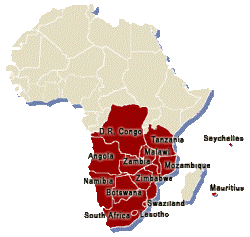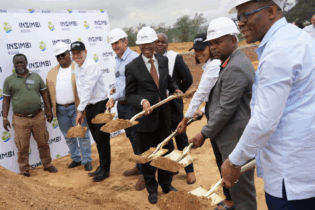Implementers of projects have the knack of focusing on what they know very well, often leaving out what they do not know. Usually, this comes back to bite them. An example is in the integration of leadership. Countries in the Southern African Development Community (SADC) region compete with each other for demand and capacity provision, which results in the inflated cost of logistics.
Rather, countries should work together. Integrating ports and funding is relatively easy. What is not available is integrated leadership in the region (excluding heads of various states), agreeing that SADC is ‘one country’. Logistics planning is still done at the country level, which is not practical, because then supply chains are being developed that are competing with each other. The sector should be cautious about acceleration, and about what is funded. One example is Transnet, whose plans should fit into regional plans, but right now they do not. The softer issues in project development often go ignored, but they are at times the most important. There should be a halt to focusing mainly on mega-projects, since they take time and money, as well as resulting in complications (excluding Grand Inga). Despite this, mega projects do create a common vision for a region. Do sponsors have the capacity to support these projects? Institutional capacity is certainly needed. At the political level, southern Africa has done well, top–down approaches are there, but things go off course when there is the attempt to get others to plug in to this. One-stop border posts are very important. It was cautioned that the region must be careful not to follow the architecture of colonial extraction, which means focusing on intra-Africa trade rather than too great a focus on ports and exports. Government and private sector must both drive natural winners and losers in markets. There is sufficient funding and policies, but project preparation is limited. What is needed is to decide how to make hubs of excellence, and decide who is going to do what. The high-level work has been done, but now the sector is facing an implementation challenge. Governments do not do regional integration very well. The private sector does the regional integration, and they suffer most when it does not work. Regional infrastructure will not happen unless there is public support for it. The most successful cross-border project was a PPP: the M4 toll road. This had a large economic impact. Also, the Port of Maputo has been successful in generating income. Ports without land side integration are useless. Projects need a soft-issue mediator; otherwise there are great ideas, but no implementation. The private sector should not see itself as a messiah, but should rather have a sense of responsibility for developing supply chains. There needs to be a clear understanding of soft issues, clear legal and policy understanding, and communication. SADC has been driving the implementation of harmonisation of vehicle load management for twenty years. A mediator between the public and private sector (such as Maputo Corridor Logistics Initiative (MCLI) is absolutely necessary. It is a stark reality how little intra-African trade there is. To address this there should be a clear target for development in future. In Namibia, there are efforts to focus on the positives in regards to transport development, even with limited resources. Namibia has been independent for 25 years; 15 years ago the Walvis Bay Corridor was created as a focus on regional integration and regional development. There are 2.2 million people in Namibia, which means a small economy. There is no real choice but to take into consideration the region and recognise the value Namibia can add. In regards to planning, in 1995 it developed its first transport master plan, and in 2014 it developed its second transport master plan (this was twenty years apart). In February 2015, it developed a logistics master plan to develop Namibia into a logistics hub in the region. It has focused on transport modes because it has a port emphasis. It started roads development. Currently, Namibia is building its first dual-carriage road (65 km), which is a big step for such a small economy. It would like to do more with sufficient funding. Namibia is also looking into what to do with aviation. As a whole, the country is trying to develop as an alternative trade route for southern Africa. Five to seven years ago, Walvis Bay was just a fishing port, but now R500 million is coming into Namibia’s economy through this post (from zero rand 10 years ago). Namibia is trying to create a better alternative in the SADC region. Now it is looking to focus on developing the manufacturing sector. Namibia is working with South Africa to develop partnerships (excluding transport corridors to production corridors). Trade liberalisation across the region is the goal for SADC. PIDA is the continental plan SADC adheres to. There is a tripartite East African Community (EAC), Common Market for Eastern and Southern Africa (COMESA) and SADC free trade agreement in talks, which would encompass 28 countries. SADC’s two key goals are free movement of persons and goods, and the implementation of a trade protocol in SADC (trade liberalisation). Infrastructure is needed to support this process. In addition, there is a Strategic Infrastructure Master Plan. The short-term action plan (first five years of implementation) focuses on mostly working with partners such as the African Union and the Development Bank of Africa. The strategy is to focus on project preparation, to ensure there is a project pipeline so that project implementation and regional integration may be accelerated. There are 16 corridors in SADC and each has a developed infrastructure action plan. There is also a need to rehabilitate rail to reduce goods transport on roads. Also, a look at the power crisis across the continent is necessary. We need to develop a proper energy mix. Countries are integrated with broadband infrastructure, but still need to reduce the cost of doing business to become more effective.Currently, the master plan is being implemented. There is a private partnership including SADC Rail, Kalahari Rail, Dar es Salaam Port, SADC Broadband Infrastructure Programme. Nine out of 12 SADC Power Networks are connected; we must connect the remaining ones to allow for power trading across the region. How can a platform be created platforms to build relationship between the strategies and policies, and can the private sector be encouraged to get more involved?
MCLI does this, and it means focusing on issues that affect regions. If governments are implementing trade facilitation measures, then we bring together users alongside customs officials and systems people and discuss issues, which then results in the refinement of issues. There is an operational focus, which shows that this work has demystified the relationship between the private and public sector. To do this, we literally put people in the same room and facilitate the issues. In essence, the private and public sector want the same things. The DRC, Namibia and Zambia were involved in a 2010 MOU at a PPP Transport Forum, discussing issues from Walvis Bay to Lubumbashi. The question was raised: what is the objective of each public and private entity? The issues were written down and the questions were raised: what needs to be done, by when, and who is responsible? This created an action plan, 75 percent of which has been written off in three years. Dialogue is important, both the public and the private sector must be present in these meetings, or else it is a waste of time. The wheels turn at different speeds in government and the private sector. There are opportunities on both sides to make things work. The private sector side is about transaction and economic value, which is often a fatal flaw, because the demands of government are not incorporated into any business plan. Also, there is a fear in the ability of government and government officials to make decisions. Are they looking to do business or to govern? To govern is facilitatory, they can do it, but they need to do it well. Money is always looking to make money. If takes too long to reach an agreement, then business moves on elsewhere. Sometimes we are afraid to implement the plans we came up with. ICT does well in attracting private sector finance. ICT is based on user-pay, so a network can be developed based on that. There will always be a demand. There is a need to find regional integration in public goods like water, and a need to find a way to involve the private sector. This discussion has not yet been held. What would PPPs for public goods look like? What can we afford, and what do we need to pay for? Political organisation is required for mega projects (such as Grand Inga), which takes a long time. Political cycles determine how and when projects are implemented, rather than a long-term project implementation plan that is needed for mega-projects to work. Mega-projects often do not involve private sector consultation early on. The reason nothing happens on a regional level (since 1980) is because the majority of national governments do not care about SADC as a whole. This is a terrifying reality, yet it is a reality. Even national development plans do not necessarily get implemented. Everyone works in cocoons, but it is not being taken seriously. Using an ICT framework on roads, for instance, would be a challenge since roads are considered public goods. When financing these things, banks look at cash flows from user pay. But there are other benefits to these projects. How do we translate this into the package of a project? The value proposition for each project and each member state and package accordingly must be looked at. There is an apparent disconnect between national policies and regional plans. Member states are often reluctant to endorse or implement SADC policies. Some national strategies are superceding regional development policies. To overcome this, efforts have been made. SADC encourages member states to integrate the regional plan into their national plans. Inevitably, there is always conflict, but at national level it comes down to how you craft it. Cross-border conflict has been reduced greatly in SADC region, which is a good starting point. We need champions in specific areas to start to create change. Consensus takes time. In addition, the effort that has been put into planning needs to shift to implementation. The Asian model for regional integration is likely the best example however it was the perfect storm economically, and perhaps cannot be replicated. The EU (European Union) and NAFTA (North American Free Trade Agreement) are not great examples. Governments do not trade, companies do. The fudging of the lines is happening and this is a problem. The private sector needs to take a stronger role.







